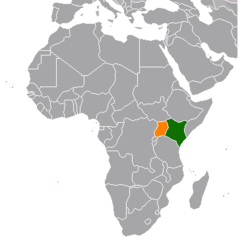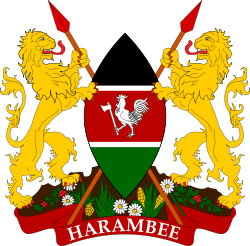Kenya–Uganda relations
 |
|
Kenya |
Uganda |
|---|---|
Kenya–Uganda relations are bilateral relations between Kenya and Uganda. The two African Great Lakes countries are partners in many areas, particularly in the trade, infrastructure, security (military), education, agriculture and energy sectors.
History
From 1961 to 1965, the two states along with Tanzania were united in the East African Common Services Organisation, a common market with a loose federal structure.[1] Kenya and Uganda were also founding members of the original East African Community (EAC), which later collapsed due to ideological differences and territorial disputes within itself.
On 7 July 2000, Kenya, Uganda, and Tanzania reestablished the EAC. It has contributed a great deal in improving trade and overall relations between Kenya and Uganda.
The countries are both inhabited by significant Swahili-speaking populations, and share a lot of cultural similarities.
High-level visits

President Museveni of Uganda has on multiple occasions made state visits to Kenya. Former President Mwai Kibaki and Incumbent Uhuru Kenyatta have made state visits to Uganda.
Trade and economy
For many years Uganda was the largest export destination for Kenyan goods. However, due to the lifting of trade restrictions within the EAC, Tanzania has become a major export destination, beating Uganda in 2014.[2]
In 2013, Kenya exported goods worth KES. 67 billion (EUR. 632 million) to Uganda. This made Uganda the 2nd largest export destination for Kenyan goods after the European Union.[3]
Uganda exported goods worth KES. 15 billion (EUR. 144 million) to Kenya. Bilateral trade was worth KES. 82.3 billion (EUR. 776 million) making Uganda Kenya's 7th largest trade partner.[3]
FDI
Many Kenyan firms have operations in Uganda, some of which are Kenya Commercial Bank, Equity Bank and Nakumatt. As of 2014, Kenya is the largest investor in the EAC.[4]
Infrastructure
Both countries are building a standard gauge railway link that would go through Mombasa-Nairobi-Kampala-Kigali. Work began on the Kenyan section of the rail line in December 2014.
There have been proposals to have the Mombasa-Nairobi-Kampala-Kigali route expanded to a motorway all the way. Uganda largely uses the port of Mombasa to get access to international markets. The standard gauge rail link will boost efficiency in delivering goods to the landlocked country from Kenya.
Uganda will also be included in the LAPSSET project in which a pipeline will link both Kenya's and Uganda's oilfields to the a new port city in Lamu, Kenya. In 2014, Toyota's parent company Toyota Tsusho got the contract design the pipeline.[5] On completion this will be the world's longest heated pipeline, covering a distance of 1380 km.[6]
Diplomatic missions
Kenya has a high commission in Kampala. Uganda maintains a high commission in Nairobi.
See also
References
- ↑ East Africa Living Encyclopedia: Kenya - Foreign Relations
- ↑ Tanzania becomes Kenya’s largest East Africa market. The EastAfrican. August 30, 2014. Retrieved January 20, 2015.
- 1 2 Kenya, Trade with World. (PDF) 2006. Retrieved January 20, 2015.
- ↑ Kennedy Kangethe, Kenya Records FDI Growth Despite Insecurity. AllAfrica.com. May 28, 2014. Retrieved January 20, 2015.
- ↑ Japan's Toyota Tsusho to design Uganda-Kenya crude pipeline. Reuters. November 26, 2014. Retrieved January 20, 2015.
- ↑ Edward Ssekika, Uganda, Kenya to build world’s longest heated oil pipeline. The Observer. Retrieved January 20, 2015.
